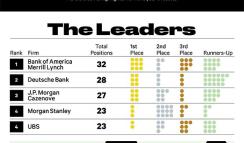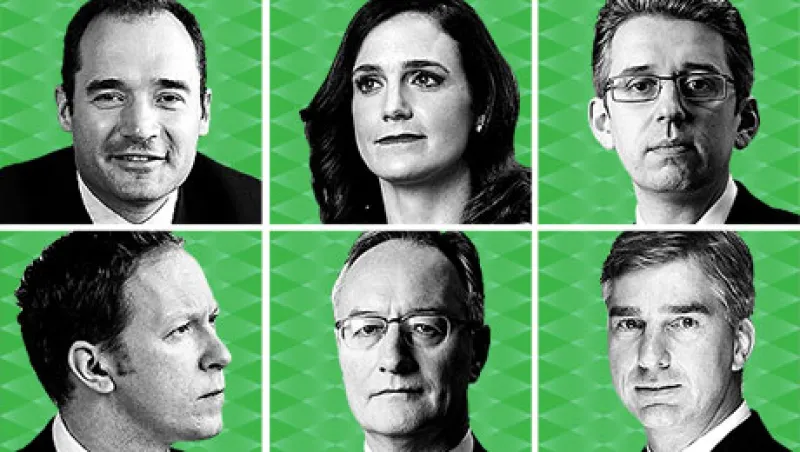World stock markets ushered in 2016 with the worst rout in years, and Europe did not escape the carnage. The benchmark MSCI Europe index tumbled 7.4 percent in the first month of the new year, its worst January performance since 2008.
Amid all the turmoil, the International Monetary Fund lowered its forecast for global real gross domestic product growth this year to 3.4 percent from 3.6 percent (and U.S. expansion to 2.6 percent from 2.8 percent) — but raised its outlook for the euro zone, from 1.6 percent to 1.7 percent. Continued low oil prices will spur consumer spending in the region, the Washington-based organization maintains.
| Related ContentThe 2016 All-Europe Sales TeamFebruary 3, 2016Europes's 2016 Top Corporate Access ProvidersFebruary 4, 2016 |
Christian Kern, who directs coverage of European equities at J.P. Morgan Cazenove, shares a similar view. “We are more cautious than IMF forecasts, expecting global growth of 2.5 percent this year and 2.8 percent next year,” the London-based researcher says. Underlying divergences in the developed- and emerging-markets business cycles will persist, he explains, and weaker advances in productivity and labor forces constrain potential economic expansion.
However, Kern and his analysts share the IMF’s more optimistic view of the euro zone’s growth prospects. “The boost from a lower euro is still feeding through, credit conditions are improving and the fiscal drag is fading,” he notes.
Predicting the future is hardly an exact science, so money managers that invest in European equities will likely touch base with the sell side more often this year for insights into what is — and isn’t — moving markets. The firm whose guidance they value most highly is Bank of America Merrill Lynch, which returns to the top of Institutional Investor’s All-Europe Research Team after falling to fourth place last year. The firm captures 32 positions, six more than in 2015, and its analysts are deemed the best in more sectors than any other firm’s: nine.
Deutsche Bank repeats in second place with 28 spots, while J.P. Morgan Cazenove — which tied with its German rival last year — slips to No. 3 after its total falls by one. Two firms share fourth place, with 23 spots apiece: Morgan Stanley, rising one rung after picking up one position; and last year’s winner, UBS, whose total plunges by seven. Click on the Leaders link in the navigation table at right to see the full results of all ranked firms.
The order changes somewhat when a weighting of 4 is applied to each first-place position, 3 to each second-place spot and so on. BofA Merrill is still triumphant, with a weighted score of 75, while J.P. Morgan Cazenove claims the second tier, with a score of 62. Morgan Stanley, with 60, climbs to third as Deutsche Bank falls to No. 4, with 55. UBS ranks fifth; its score is 46. Click on Weighting the Results in the navigation table to see how each firm fares when this formula is applied.
The survey’s 45 sectors are grouped into three broad areas of coverage: Countries & Regions (nine sectors), Economics & Strategy (four) and Industries (32). When the results of each category are viewed independently, Kepler Cheuvreux outperforms all others in Countries & Regions, J.P. Morgan Cazenove and UBS share first place in Economics & Strategy, and BofA Merrill is No. 1 in Industries.
Paul Reynolds, head of EMEA equity research at Deutsche Bank in London, also believes that the euro zone will be a bit of a bright spot, relatively speaking, in a world economy growing increasingly gloomy. “There are clear signs of deteriorating global economic momentum, due to weaker growth in the U.S. and emerging markets,” he notes. “European growth momentum is holding up well for now on the back of [European Central Bank] easing, the falling oil prices and easier fiscal policy.”
His colleague Mark Wall captains the team that earns a fifth consecutive victory in Economics. “The factors behind the resilience of euro area growth forecasts in 2015 are just as relevant this year — easy monetary policy, easy fiscal policy and even lower oil prices than we were thinking,” he says. “The combination is particularly supportive for domestic demand. If euro area GDP cannot grow 1.5 to 2.0 percent with these drivers, it never will.”
Next year will likely be more problematic, he adds. “The drivers of the recovery are cyclical not structural,” Wall contends. “Oil prices won’t keep falling into 2017, and fiscal policy won’t be as loose. Nor will monetary policy keep easing. Core inflation troughed in the first half of 2015, and yet more ECB easing will underpin the gradual recovery in core inflation — particularly if the economic recovery proves resilient this year. But losing all the cyclical props means economic growth will probably slow in 2017.”
Not all markets within the euro zone will be equally affected. “Among the larger member states, growth momentum looks most favorable in Italy and Spain — the fiscal and credit dynamics are more supportive,” the London-based economist attests. “Germany has the weakness of being the most exposed to trade with [Brazil, Russia, India and China].”
J.P. Morgan’s Kern, who also leads the team that outpaces all others when it comes to coverage of the United Kingdom, is advising clients to overweight euro zone stocks — with one noteworthy exception.
“The domestic recovery is in its early stages, the ECB is likely to deliver further support, and earnings still have significant upside potential,” he says. “We are keeping our long-standing underweight on U.K. equities, due to overrepresentation of high price-to-earnings growth stocks and commodities in the FTSE 100 Index, but remain positive on domestic cyclical names such as U.K. homebuilders.”
Greenwell, who also oversees the BofA Merrill squad that ties for second place (with Richard Paige’s Barclays crew) for reporting on U.K. names, says his analysts are steering investors away from autos, “where we are underweight because of structural margin pressure in China — we have no buys on German autos, which are most exposed” — and toward industrials.
“Our largest variance versus the consensus is euro zone inflation, where we believe at current foreign exchange and oil prices we will see negative inflation by midyear,” he maintains. “The consensus assumes a 0.8 percent positive rate for 2016.”
Click on the image below to view an infographic highlighting the results of the 2015 All-Europe Research Team survey.

Deflation will prompt the ECB to act, Wall believes. “The message portrayed by Mario Draghi at the last press conference was clearly dovish. More than that, he seemed to be speaking on behalf of the overall council, making the message more credible and powerful,” the Deutsche Bank economist attests. However, “the weaker are the ECB staff inflation forecasts and the greater the risks to China, oil prices and so on, the more likely the ECB will announce more quantitative easing — but at this stage, we believe it would be no more than a front-loading of their current QE plans.”
The 2016 All-Europe Research Team reflects the opinions of 2,139 money managers at 784 institutions overseeing an estimated $6 trillion in European equities.
Click on the Best Analysts of the Year in the navigation table to view profiles of the researchers and teams in first, second and third places, and to find information about when they debuted in their sectors, the total number of appearances they have amassed to date, their total appearances at No. 1 (where applicable) and comments from money managers about what distinguishes these analysts from their peers. Also available at that link is a list of squads that earn a runner-up spot in each sector (where applicable). Please note: Information about researchers in the second and third positions, and runners-up, is available to subscribers only.
To learn more about how this ranking was compiled, click on Methodology.






